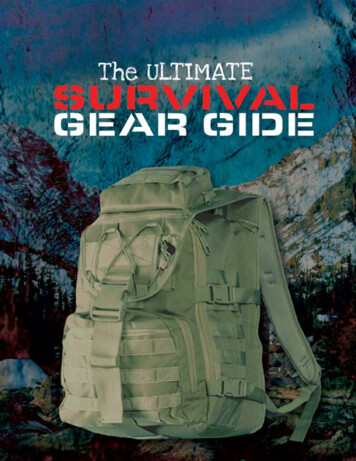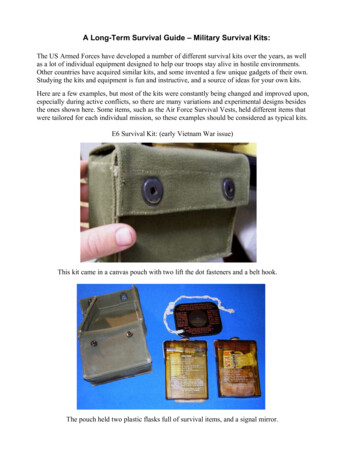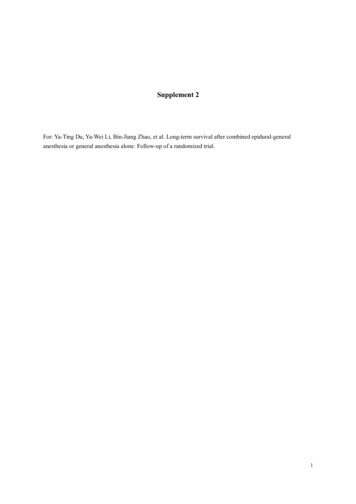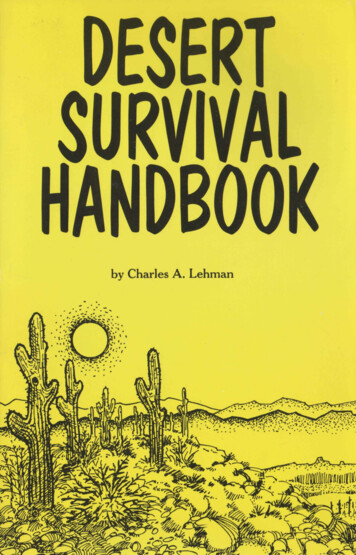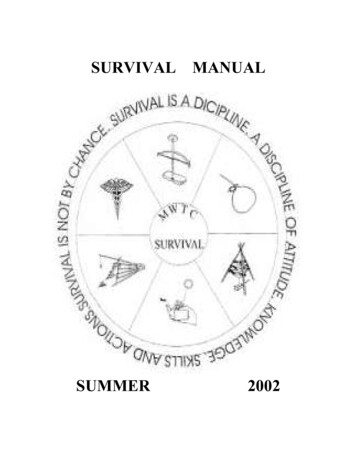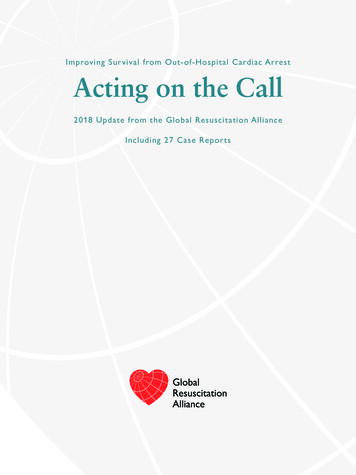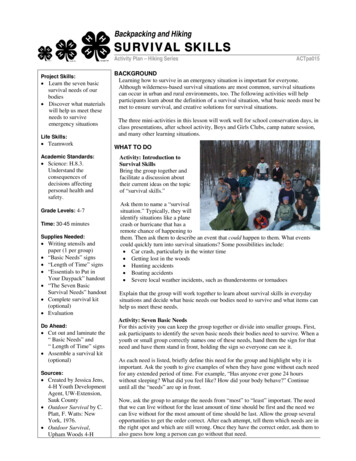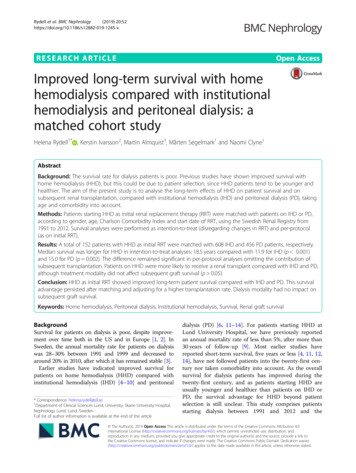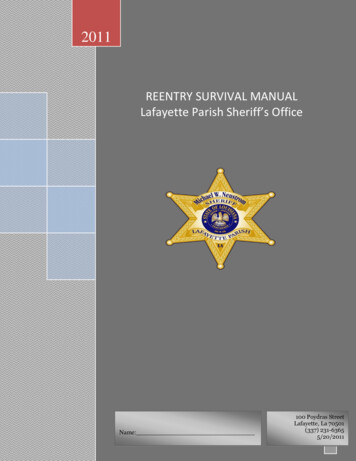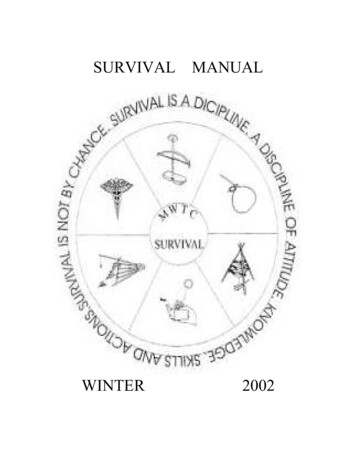
Transcription
SURVIVALWINTERMANUAL2002
UNITED STATES MARINE CORPSMountain Warfare Training CenterBridgeport, California 93517-5001WINTER SURVIVAL COURSE HANDBOOKTABLE OF REMENTS FOR SURVIVALSURVIVAL KITWATER PROCUREMENTEXPEDIENT SHELTERS AND FIRESCORE VALUES AND MOUNTAIN LEADERSHIP CHALLENGESSURVIVAL SIGNALING AND RECOVERYSURVIVAL NAVIGATIONTRAPS AND SNARESUSES FOR GAMESURVIVAL FISHINGFIELD EXPEDIENT TOOLS, WEAPONS, AND EQUIPMENTEXPEDIENT SNOWSHOESWINTER TRACKINGSURVIVAL MEDICINEWEATHERINTRO TO EVASIONAVALANCHE AND ICE HAZARDSAPPENDIXABCDEFEVASION PLAN OF ACTION FORMAT“THE EDGE” GUIDED DISCUSSIONSURVIVAL QUICK REFERENCE CHECKLISTANIMAL HABITSTACTICAL CONSIDERATIONSGRADING STANDARDS
UNITED STATES MARINE CORPSMountain Warfare Training CenterBridgeport, California 93517-5001WSVX 02.0102/06/05STUDENT HANDOUTREQUIREMENTS FOR SURVIVALTERMINAL LEARNING OBJECTIVE In a cold weather mountainous environment, apply therequirements for survival, in accordance with the references. (WSVX.02.01)ENABLING LEARNING OBJECTIVES(1) Without the aid of references and given the acronym “SURVIVAL”, describe in writing theacronym “SURVIVAL”, in accordance with the references. (WSVX.02.01a)(2) Without the aid of references, list in writing the survival stressors, in accordance with thereferences. (WSVX.02.01b)(3) Without the aid of references, list in writing the priorities of work in a survival situation, inaccordance with the references. (WSVX.02.01c)OUTLINE1. REQUIREMENTS FOR SURVIVALa. This mental “mind-set” is important in many ways. We usually call it the “will to survive”although you might call it “attitude” just as well. This basically means that, if you do nothave the right attitude, you may still not survive.b. A guideline that can assist you is the acronym “ SURVIVAL”. (WSVX.02.01a)(1) Size up.(a) Size up the situation.1. Conceal yourself from the enemy.2. Use your senses to hear, smell, and see to determine and consider whatis developing on the battlefield before you make your survival plan.(b) Size up your surroundings.WSVX 02.0101-1
1. Determine the rhythm or pattern of the area.2. Note animal and bird noises and their movement.3. Note enemy traffic and civilian movement.(c) Size up your physical condition.1. Check your wounds and give yourself first aid.2. Take care to prevent further bodily harm.3. Evaluate condition of self and unit prior to developing survivalplan.(d) Size up your equipment.1. Consider how available equipment may affect survival senses;tailor accordingly.(2) Undue haste makes waste.(a) Plan your moves so that you can move out quickly withoutendangering yourself if the enemy is near.(3) Remember where you are.(a) If you have a map, spot your location and relate it to the surroundingterrain.(b) Pay close attention to where you are and where you are going.Constantly orient yourself.(c) Try to determine, at a minimum, how your location relates to thefollowing:1. The location of enemy units and controlled areas.2. The location of friendly units and controlled areas.3. The location of local water sources.4. Areas that will provide good cover and concealment.(4) Vanquish fear and panic.01-2WSVX 02.01
(a) Realistic and challenging training builds self-confidence and confidence for aunit’s leadership.(b) The feeling of fear and panic will be present. The survivor mustcontrol these feelings.(5) Improvise and Improve.(a) Use tools designed for one purpose for other applications.(b) Use objects around you for different needs. (i.e. use a rock for ahammer)(6) Value living.(a) Place a high value on living.(b) Refuse to give into the problem and obstacles that face you.(c) Draw strength from individuals that rise to the occasion.(7) Act like the natives.(a) Observe the people in the area to determine their daily eating, sleeping, anddrinking routines.(b) Observe animal life in the area to help you find sources of food andwater.NOTES: Remember that animal reactions can reveal your presence to the enemy.Animals cannot serve as an absolute guide to what you can eat and drink.(8) Live by your wits, but for now, learn basic skills.(a) Practice basic survival skills during all training programs and exercises.2. STRESS. Stress has many positive benefits. Stress provides us with challenges: it gives us chancesto learn about our values and strengths. Too much stress leads to distress. While many of these signsmay not be self-identified, it remains critical that all survivors remain attentive to each other’s signsof distress. Listed are a few common signs of distress found when faced with too much stress:a. Difficulty in making decisions (do not confuse this sign for a symptom ofhypothermia).b. Angry outbursts.c. Forgetfulness.WSVX 02.0101-3
d. Low energy level.e. Constant worrying.f. Propensity for mistakes.g. Thoughts about death or suicide.h. Trouble getting along with others.i. Withdrawing from others.j. Hiding from responsibilities.k. Carelessness.3. SURVIVAL STRESSORS. (WSVX.02.01b) Any event can lead to stress. Often, stressful eventsoccur simultaneously. These events are not stress, but they produce it and are called “stressors”. Inresponse to a stressor, the body prepares either to “fight or flee”. Stressors add up. Anticipatingstressors and developing strategies to cope with them are the two ingredients in the effectivemanagement of stress. It is essential that the survivor be aware of the types of stressors he willencounter.a. Injury, Illness, or Death. Injury, illness, and death are real possibilities a survivor has to face.Perhaps nothing is more stressful than being alone in an unfamiliar environment where youcould die from hostile action, an accident, or from eating something lethal.b. Uncertainty and Lack of Control. The only guarantee in a survival situation is that nothing isguaranteed. This uncertainty and lack of control also add to the stress of being ill, injured, orkilled.c. Environment. A survivor will have to contend with the stressors of weather, terrain, and thevariety of creatures inhabiting an area. Heat, cold, rain, winds, snow, mountains, insects, andanimals are just a few of the challenges awaiting the Marine working to survive.d. Hunger and Thirst. Without food and water a person will weaken and eventually die. Gettingand preserving food and water takes on increasing importance as the length of time in asurvival setting increases. With the increased likelihood of diarrhea, replenishing electrolytesbecomes critical. For a Marine used to having his provisions issued, foraging can be a bigsource of stress.e. Fatigue. It is essential that survivors employ all available means to preserve mental andphysical strength. While food, water, and other energy builders may be in short supply,maximizing sleep to avoid deprivation is a very controllable factor. Further, sleepdeprivation directly correlates with increased fear.01-4WSVX 02.01
f. Isolation. Being in contact with others provides a greater sense of security and a feelingsomeone is available to help if problems occur.4. NATURAL REACTIONS. Man has been able to survive many shifts in his environment throughoutthe centuries. His ability to adapt physically and mentally to a changing world kept him alive. Theaverage person will have some psychological reactions in a survival situation. These are some of themajor internal reactions you might experience with the survival stressors.a. Fear. Fear is our emotional response to dangerous circumstances that we believe have thepotential to cause death, injury, or illness. Fear can have a positive function if it encouragesus to be cautious in situations where recklessness could result in injury.b. Anxiety. Anxiety can be an uneasy, apprehensive feeling we get when faced with dangeroussituations. A survivor reduces his anxiety by performing those tasks that will ensure hiscoming through the ordealc. Anger and Frustration. Frustration arises when a person is continually thwarted in hisattempts to reach a goal. One outgrowth of frustration is anger. Getting lost, damaged orforgotten equipment, the weather, inhospitable terrain, enemy patrols, and physicallimitations are just a few sources of frustration and anger. Frustration and anger encourage,irrational behavior, poorly thought-out decisions, and, in some instances, an “I quit” attitude.d. Depression. Depression is closely linked with frustration and anger when faced with theprivations of survival. A destructive cycle between anger and frustration continues until theperson becomes worn down-physically, emotionally, and mentally. At this point, he starts togive up, and his focus shifts from “What can I do” to “There is nothing I can do.”e. Loneliness and Boredom. Man is a social animal and enjoys the company of others.Loneliness and boredom can be another source of depression. Marines must find ways tokeep their minds productively occupied.f. Guilt. The circumstances leading to your survival setting are sometimes dramatic and tragic.It may be the result of an accident or military mission where there was a loss of life. Perhapsyou were the only, or one of a few, survivors. While naturally relieved to be alive, yousimultaneously may be mourning the deaths of others that were less fortunate. Do not letguilt feelings prevent you from living.5. PRIORITIES OF WORK IN A SURVIVAL SITUATION. (WSVX.02.01c) Each survivalsituation will have considerable aspects that will alter the order in which tasks need to beaccomplished. A general guideline is to think in blocks of time.a. First 24 hours. The first 24 hours are critical in a survival situation. You must make aninitial estimate of the situation. Enemy, weather, terrain, time of day, and available resourceswill determine which tasks need to be accomplished first. They should be following.(1) Shelter(2) FireWSVX 02.0101-5
(3) Water(4) Signalingb. Second 24 hours. After the first 24 hours have passed, you will now know you can survive.This time period needs to be spent on expanding your knowledge of the area. By completingthe following tasks, you will be able to gain valuable knowledge.(1) Tools and weapons. By traveling a short distance from your shelter to locate thenecessary resources, you will notice edible food sources and game trails.(2) Traps and snares. Moving further away from your shelter to employ traps and snares,you will be able to locate your shelter area form various vantage points. This willenable you to identify likely avenues of approach into your shelter area.(3) Pathguards. Knowing the likely avenues of approaches, you can effectively placenoise and causality producing pathguards to ensure the security of your shelter area.c. Remainder of your survival situation. This time is spent on continuously improving yoursurvival situation until your rescue.6. GROUP SURVIVAL. In group survival, the group’s survival depends largely on its ability toorganize activity. An emergency situation does not bring people together for a common goal; rather,the more difficult and disordered the situation, the greater are the disorganized group’s problems.a. Groups Morale. High morale must come from internal cohesiveness and not merely throughexternal pressure. The moods and attitudes can become wildly contagious. Conscious wellplanned organization and leadership on the basis of delegated or shared responsibility oftencan prevent panic. High group morale has many advantages.(1) Individual feels strengthened and protected since he realizes that his survivaldepends on others whom he trusts.(2) The group can meet failure with greater persistency.(3) The group can formulate goals to help each other face the future.b. Factors that Influence Group Survival. There are numerous factors that will influencewhether a group can successfully survive.(1) Organization of Manpower - Organized action is important to keep all members ofthe group briefed; this way the members of the group will know what to do and whento do it, both under ordinary circumstances and in emergencies.(2) Selective Use of Personnel - In well-organized groups, the person often does the jobthat most closely fits their personal qualifications.01-6WSVX 02.01
(3) Acceptance of Suggestion and Criticisms - The senior man must acceptresponsibility for the final decision, but must be able to take suggestion andcriticisms from others.(4) Consideration of Time - On-the-spot decisions that must be acted upon immediatelyusually determines survival success.(5) Check Equipment - Failure to check equipment can result in failure to survive.(6) Survival Knowledge and Skills - Confidence in one’s ability to survive is increasedby acquiring survival knowledge and skills.REFERENCE:1.2.3.4.5.Barry Davies BME, SAS Escape, Evasion, and Survival Manual, 1996.FM 21-76, Survival, 1992.John Wiseman, SAS Survival Guide, 1986.AFM 64-5, Search and Rescue Survival, 1969.B-GA-217-001/PT-001, Down but not Out.WSVX 02.0101-7
UNITED STATES MARINE CORPSMountain Warfare Training CenterBridgeport, California 93517-5001WSVX 02.022/6/05STUDENT HANDOUTSURVIVAL KITTERMINAL LEARNING OBJECTIVE. In a cold weather mountainous environment,construct a survival kit, in accordance with the references. (WSVX.02.02)ENABLING LEARNING OBJECTIVES.(1) Without the aid of references, list in writing the components for a survival kit, inaccordance with the references. (WSVX.02.02a)(2) Without the aid of references, list in writing one example of each component for asurvival kit, in accordance with the references. (WSVX.02.02b)OUTLINE1. COMPONENTS FOR A SURVIVAL KITa. The environment is the key to the types of items you will need in your survival kit.How much equipment you put in your kit depends on how you will carry the kit. A kiton your body will have to be much smaller than one carried in a vehicle.b. Always layer your survival kit, keeping the most important items on your body.c. In preparing your survival kit, select items that can be used for more than onepurpose.d. Your survival kit does not need to be elaborate. You only need functional items thatwill meet your needs and a case to hold them. The case might be a first aid case, anammunition pouch, or another suitable case. This case should be(1) Water repellent or waterproof.(2) Easy to carry or attach to your body.(3) Suitable to accept various sized items.(4) Durable.02-1WSVX.02.02
e. When constructing a survival kit, you should have the following components:(WSVX.02.02a)(1) Fire starting items.(2) Water procurement items.(3) Food procurement items.(4) Signaling items.(5) First aid items.(6) Shelter items.2. ITEMS CONTAINED WITHIN EACH COMPONTENT (WSVX.02.02b)a. Fire Starting Equipment(1) Matches.(2) Magnifying glass.(3) Flint and Steel.(4) Lighter.(5) Potassium Permanganate, with container of sugar or anti-freeze.(6) Prepackaged Tinder.-Commercially Manufactured-Cotton Balls and Petroleum Jellyb. Water Procurement Item.(1) Water Disinfecting Chemicals.-Iodine Tablets-Betadine Solution-Iodine Solution-Bleach(2) Metal Container. (Serves for boiling water)-Canteen Cup-Survival Kit Container-Any Suitable can that contained no petroleum products.2
(3) Water Carrying Items.-Canteen-Plastic Bag-Plastic/Metal/Glass Container which contained no petroleum products.c. Food Procurement Items.(1) Fish.-Various sized hooks-Various sized sinkers/weights-Metal leaders and swivels-Small weighted jigs-Fishing line-Think about the size of fish for that environment when selecting weightsand sizes.(2) Game.-Snares*Commercially Manufactured*Aircraft Cable*Tie Wire/ Comm Wire-Bait*MRE Cheese Spread, Jelly, or Peanut Butter Package*Fishing Bait-550 Cord for Gill Net and Trap Construction-Engineer/Marking Tape-Sling shot rubber and pouch-Large treble hooksd. Signaling Items(1) Day-Mirror-Whistle-Pyrotechnics (Smoke, Pen Flares)-Air Panels/ Brightly colored material(2) Night.-Pyrotechnics (Pen Flares, Star Clusters)-Lights (Flashlight, Strobe, Chemlight)-Whistle-Buzz Saw02-3WSVX.02.02
e. Shelter Items(1) Cordage.- 550 Cord.- Wire.-Communication wire-Tie wire(2) Finger Saw.(3) Sewing Kit with Needles for construction/repair of clothing.(4) Tentage.-poncho-space blanket(5) Candle.f. First Aid Items(1) Band-Aids.-Steristrips-Adhesive Tape-Non-stick pads, 4x4’s, Gauze, Battle Dressings-Muslin Bandage-Butter flies w/ Super glue(2) Ointments.-Burn-Anti-septic(3) Miscellaneous.-Salt-Sugar-Eye Wash-Alcohol prep pads-Suture Kit-Scalpel-Vile of Yarrowg. Miscellaneous items.(1) Fingernail clippers.4
(2) Compass.(3) Notebook with pen or pencil.(4) Wood eye screws and nails.(5) Surgical tubing.Note: It is assumed that the Marine is always carrying a high quality fixed bladed knife, amulti-tool knife, and a sharpening stone.REFERENCE:1. Barry Davies BME, SAS Escape, Evasion, and Survival Manual, 1996.2. FM 21-76, Survival, 1992.3. John Wiseman, SAS Survival Guide, 1986.02-5WSVX.02.02
UNITED STATES MARINE CORPSMountain Warfare Training CenterBridgeport, California 93517-5001WSVX.02.032/6/05STUDENT HANDOUTWATER PROCUREMENTTERMINAL LEARNING OBJECTIVE In a cold weather mountainous environment, andgiven water procurement materials, obtain potable water, in accordance with the references.(WSVX.02.03)ENABLING LEARNING OBJECTIVES(1) Without the aid of references, describe in writing why ice is more preferable thansnow for melting into drinking water, in accordance with the references. (WSVX.02.03a)(2) Without the aid of references, list in writing the hazardous fluids to avoidsubstituting for potable water, in accordance with the references. (WSVX.02.03b)(3) Without the aid of references, list in writing the methods for disinfecting water, inaccordance with the references. (WSVX.02.03c)(4) Without the aid of references, and given a military bottle of water purification tablets,state in writing its self-life, in accordance with the references. (WSVX.02.03d)(5) Without the aid of references, and given the water temperature and chemicalconcentration, state in writing the contact time to disinfect water, in accordance with thereferences. (WSVX.02.03e)(6) Without the aid of references, construct a water generator, in accordance with thereferences. (WSVX.02.03f)OUTLINE1. WATER INTAKEa. Thirst is not a strong enough indicator.b. The best plan is to drink utilizing the OVER DRINK method. Drink plenty of waterwhen it is available especially when eating.WSVX.02.0303-1
c. Dehydration is a major threat. A loss of only 5 % of your body fluids causes thirst,irritability, nausea, and weakness; a 10% loss causes dizziness, headache, inability towalk, and a tingling sensation in limbs; a 15% loss causes dim vision, painfulurination, swollen tongue, deafness, and a feeling of numbness in the skin; also a lossof more than 15% body fluids could result in death.d. Your water requirements will be increased if:(1) You have a fever.(2) You are experiencing fear or anxiety.(3) You evaporate more body fluid than necessary. (i.e., not using the propershelter to your advantage)(4) You have improper clothing.(5) You ration water.(6) You overwork.2. LOCATING WATER.a. The environment may sometimes provide you with opportunities to acquire water. Ina cold weather mountainous region water can generally be located in the following:(1) Snow. Snow can be melted for potable water. Melting snow will result in ahigher fuel usage. Uncontaminated snow does not need to be disinfected.(2) Ice. (WSVX.02.03a) Ice can be melted for potable water. Melting ice ispreferable to melting snow due to the higher concentration of water pervolume. However, since ice is frozen water it needs to be disinfected.(3) Streams and Rivers. Streams and rivers can generally be found in amountainous region. Extreme caution must be used when approaching theedge to avoid accidental cold-water submersion.(4) Sea Ice. In time, sea ice loses its salinity. You can identify this ice by itsrounded corners and bluish color. Gray ice has not yet lost its salt content.b. The following are some general considerations when using snow and ice for water.(1) Never melt snow or ice inside your mouth. This removes body heat andincreases the chance of cold weather injuries.03-2WSVX.02.03
(2) When on the move, use body heat to melt snow. Place snow or ice in a waterbag and place the bag between your layers of clothing, not directly on the skin.(3) Do not waste fuel to melt snow or ice when drinkable water (i.e., stream) isavailable.(4) If melting snow in a container by a fire, utilize a hot rock to speed up theprocess and conserving fuel.3. HAZARDOUS FLUIDS (WSVX.02.03b)a. Survivors have occasionally attempted to augment their water supply with other fluidssuch as; alcoholic beverages, urine, blood, or seawater. While it is true that each ofthese fluids have high water content, the impurities they contain require the body toexpend more fluid to purify them.(1) Seawater. Seawater in more than minimal quantities is actually toxic. Theconcentration of sodium and magnesium salts in it is so high that fluid must bedrawn from the body to eliminate the salts and eventually the kidneys cease tofunction.(2) Alcohol. Drinking alcoholic liquids will dehydrate the body, reduce bodyheat, and cloud judgment. Ingesting a super-cooled liquid can causeimmediate frostbite of the throat and possible death.(3) Blood. Blood is considered a food. Drinking blood will require your body toexpend additional fluid in order to digest it.(4) Urine. Drinking urine is foolish. Urine is nothing more than body waste.Drinking urine returns waste into your body and requires more fluid to expelit.4. WATER QUALITY. Water contains minerals, toxins, and pathogens. If consumed in largeenough quantities these may be harmful to human health. Pathogens are our primary concern.Pathogens are divided into Virus, Cysts, Bacteria, and Parasites. Certain pathogens are moreresistant to chemicals and small enough to move through microscopic holes in equipment (i.e., Tshirt, parachute). Certain pathogens also have the ability to survive in extremely cold watertemperatures. Water quality is divided into three levels of safety. Disinfection as the most desiredlevel followed by purified then potable.a. Disinfection. Water disinfection removes or destroys harmful microorganisms.Giardia cysts are an ever-present danger in clear appearing mountain water throughoutthe world. By drinking non-potable water you may contract diseases or swalloworganisms that could harm you. Examples of such diseases or organisms are:Dysentery, Cholera, Typhoid, Flukes, and Leeches.WSVX.02.0303-3
b. Impure water, no matter how overpowering your thirst, is one of the worst hazards ina survival situation.c. The first step in disinfecting is to select a treatment method. The two methods wewill discuss are as follows: (WSVX.02.03c)(1) Heat. The Manual of Naval Preventive Medicine (P-5010) states that youmust bring the water to a rolling boil before it is considered safe for humanconsumption. This is the most preferred method.(a) Bringing water to the boiling point will kill 99.9% of all Giardia cysts.The Giardia cyst dies at 60OC and Cryptosporidium dies at 65C. Waterwill boil at 14,000 ft at 86OC and at 10,000’ at 90C. With this in mindyou should note that altitude does not make a difference unless you areextremely high.(2) Chemicals. There are numerous types of chemicals that can disinfect water.These chemicals are called halogens. In a survival situation, you will usewhatever you have available.(a) Iodine Tablets.(b) Chlorine Bleach.(c) Iodine Solution.(d) Betadine Solution.(e) Military water purification tablets. (WSVX.02.03d) These tablets arestandard issue for all DOD agencies. These tablets have a shelf life offour years from the date of manufacture unless opened. Once the seal isbroken, the shelf life is one year not to exceed the initialexpiration date of four years.49703Month / Year / Batch Number(3) Water Disinfection Techniques and Halogen Doses.03-4WSVX.02.03
Iodination techniquesAdded to 1 liter or quart of waterIodine tabletsTetraglcine hydroperiodide EDWGTPotable AquaGlobaline2% iodine solution (tincture)10% povidone-iodine solution*Chlorination techniquesHousehold bleach 5%Sodium hypochlorieAquaClearSodium dichloroisocyanurateAquaCure, AquaPure, Chlor-flocChlorine plus flocculating agentAmount for4 ppmAmount for8 ppm½ tablet1 tablet0.2 ml5 gtts0.35 ml8 gtts0.4 ml10 gtts0.70 ml16 gttsAmount for5 ppmml2 gttsAmount for10 ppmml4 gtts1 tablet8 ppm1 tablet*Providone-iodine solutions release free iodine in levels adequate for disinfection, but scant datais available.Measure with dropper (1 drop 0.05 ml) or tuberculin syringePpm-part per million gtts-dropsConcentration ofhalogen2 ppm4 ppm8 ppmml-milliliterContact time in minutes at various water temperatures (WSVX.2.3e)5 C / 40 F2401806015 C / 60 F180503030 C / 85 F604515Note: These contact times have been extended from the usual recommendations to account forrecent data that prolonged contact time is needed in very cold water to kill Giardia cysts.Note: chemicals may not destroy Cryptosporidium due to its extremely tough membrane.d. Purification. Water purification is the removal of organic and inorganic chemicalsand particulate matter, including radioactive particles. While purification canWSVX.02.0303-5
eliminate offensive color, taste, and odor, it may not remove or kill allmicroorganisms.(1) Commercial Water Filters. Commercial water filters are generally available inmost retail stores and may be with you. Understanding what the filter can do isthe first step in safeguarding against future illnesses.(a) A filter with greater than a .03 micron opening will not stopCryptosporidium.(b) A filter system that does not release a chemical (i.e., iodine) may notkill all pathogens.(c) A filter that has been overused may be clogged. Usage may result inexcessive pumping pressure that can move harmful pathogens throughthe opening. Filter chambers may become plugged causing thepathogen to mutate.e. Potable. Potable only indicates a water source, on average over a period of time,contains a "minimal microbial hazard," so the statistical likelihood of illness isacceptable.(1) Sedimentation. Sedimentation is the separation of suspended particles largeenough to settle rapidly by gravity. The time required depends on the size ofthe particle. Generally, 1 hour is adequate if the water is allowed to sit withoutagitation. After sediment has formed on the bottom of the container, the clearwater is decanted or filtered from the top. Microorganisms, especially cysts,eventually settle, but this takes longer and the organisms are easily disturbedduring pouring or filtering. Sedimentation should not be considered a meansof disinfection and should be used only as a last resort or in an extremetactical situation.5. WATER GENERATOR. (WSVX.02.03f)a. General. Ice is a better source for obtaining water than snow because of higher watercontent. It takes approximately 3-4 cups of snow for each cup of water.(1) Never let the generator completely run out of snow or ice.(2) Once started the generator will supply more than enough water for 2 people.b. Construction. Material will be determined by what you are carrying: parachute, plasticbag, T-shirt, or bark.03-6WSVX.02.03
(1) If wood is available, gather three poles, approximately six feet long and threeinches in diameter. Tie them together forming a tripod.(2) Fill the material (T-shirt, parachute, or plastic bag) with snow and tiecompletely shut. Constantly bang it on the ground to compact the snow,making it dense. Add more snow and repeat the process until the material iscompletely full.(3) Tie the material of snow to the tripod and place near the fire. Ensure thematerial is safe from being burnt from the fire.(4) In about 1/2 hour, the generator will start to drip from one spot. Place any kindof container under this drip.(5) Add snow as necessary.(6) If wood is not readily available to construct a tripod, a variation can beconstructed by securing a single pole to a tree. Tie the bag of snow to thissingle pole. Snow can be placed on bark. The bark can be placed near the fireat a slight angle and the melted water collected.WSVX.02.0303-7
WATER GENERATORREFERENCE:FM 21-76, Survival, 1992.Paul Auerbach, Wilderness Medicine, 3rd Edition, 1995Howard Backer MD, MPH, Field Water Disinfection, 1999Eric Cudnohoske, Wisconsin Pharmacal Company, 199903-8WSVX.02.03
UNITED STATES MARINE CORPSMountain Warfare Training CenterBridgeport, California 93517-5001WSVX.02.04WSVX.02.0502/06/05STUDENT HANDOUTEXPEDIENT SHELTERS AND FIRESTERMINAL LEARNING OBJECTIVE(1) In a cold weather mountainous environment, construct shelters, in accordance withthe references. (WSVX.02.04)(2) In a cold weather mountainous environment, construct fires, in accordance with thereferences. (WSVX.02.05)ENABLING LEARNING OBJECTIVES(1) Without the aid of reference, list in writing the characteristics of a safe expedientshelter, in accordance with the references. (WSVX.02.04a)(2) Without the aid of references, list in writing the hazards to avoid when using naturalshelters, in accordance with the references. (WSVX.02.04b)(3) Without the aid of references, list in writing man-made snow survival shelters, inaccordance with the references. (WSVX.02.04c)(4) In a cold weather mountainous environment, list in writing the tactical fire lay, inaccordance with the references. (WSVX.02.05a)(5) In a cold weather mountainous environment, start a fire using a primitive method, inaccordance with the references. (WSVX.02.05b)OUTLINE1. BASIC CRITERIA FOR SHELTER. (WSVX.02.04a) Any type of shelter, whether itis a permanent building, tentage, or a survival shelter must meet six basic criteria to besafe and effective. The goal is you must Prepare For Some Very Hard Days.a. Protection From the Elements. The shelter must provide protection from rain, snow,wind, sun, etc.WSVX.02.0404-1
b. Free from Natural Hazards. Shelters should not be
2 survival kit 3 water procurement 4 expedient shelters and fires 5 core values and mountain leadership challenges 6 survival signaling and recovery 7 survival navigation 8 traps and snares 9 uses for game 10 survival fishing 11 field expedient tools, weapons, and equipment 12 expedient snowshoes 13 winter


